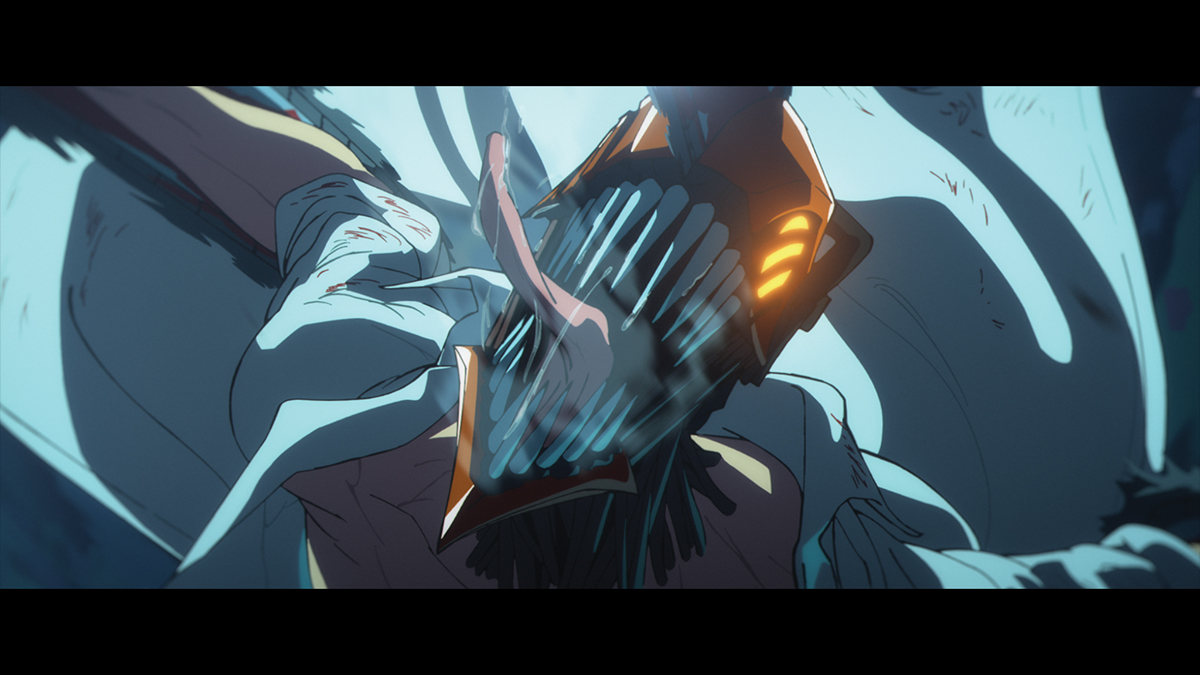Chainsaw Man – The Movie: Reze Arc Brings a Beloved Manga to Life
MAPPA’s CGI Producer Yusuke Tannawa reveals how the Reze Arc became Chainsaw Man's first feature effort.

This article is presented in partnership with Sony Pictures and appears in the NYCC 2025 issue of Den of Geek magazine.
Few anime have completely redefined the public’s perception of what’s possible in the medium like Chainsaw Man. Based on Tatsuki Fujimoto’s popular manga serialized in Weekly Shonen Jump, the anime hasn’t just redefined anime concepts, but torn through them and bathed in the bloody aftermath.
Chainsaw Man’s TV series chronicles Denji’s tumultuous acclimation to his role not only as Chainsaw Man but also as a member of the Public Safety Devil Hunters. The TV series hit impressive heights, but it’s ready to go for broke with the release of its first feature film. Chainsaw Man – The Movie: Reze Arc is an adaptation of the manga’s highly acclaimed Reze Arc, which sees Denji endeavor to bond with a mysterious new girl named Reze, which could lead to romantic bliss or Chainsaw Man’s undoing.
Yusuke Tannawa has been a leading force on Chainsaw Man’s CG production, which has carried over to Chainsaw Man – The Movie: Reze Arc. Tannawa is MAPPA’s CGI Producer and one of the studio’s leading voices in CGI development and production. Tannawa has previously worked on some of the biggest and most visually dynamic anime of the past decade, including Dorohedoro, Kakegurui, Hell’s Paradise, Attack on Titan: The Final Season, and Jujutsu Kaisen.
With the movie’s North American debut scheduled for Oct. 24, Yusuke Tannawa breaks down the challenges behind adapting Chainsaw Man’s Reze Arc, bringing the film’s explosive Devil powers to life, and why Chainsaw Man – The Movie: Reze Arc is just as much a twisted love story as it is an action epic.
Den of Geek: Chainsaw Man’s Reze Arc has such an acclaimed reputation. Can you speak at all about the decision to present this arc as a movie, rather than as part of season two?
Yusuke Tannawa: The Reze Arc is an episode depicted across Volumes 5 and 6 of the original comic, in which Denji’s encounter with Reze, their interactions, misunderstandings, the battles, and the shocking conclusion all form a complete story. Because of this, we felt that rather than dividing it into a TV series, telling the story in its entirety as a feature film would better capture and convey the story’s tension and emotional range.
In addition, when considering the runtime, the story fit perfectly within about two hours without excess or omission, making it clear that a film format was the most suitable choice. Also, by designing the entire arc as a single continuous narrative, we were able to define the color palette and tone of each scene in advance. This approach became a key factor in shaping the film into a richer, more immersive cinematic experience.
You’ve worked on some remarkable action series throughout your career. What makes Chainsaw Man’s action and visuals unique?
The action in Chainsaw Man is not merely about pursuing speed or flashy spectacles. Its defining feature lies in a raw sense of realism, making the audience feel the pain of flesh being torn and the weight of the chainsaw through the screen. Sparks flying as blades grind against walls and floors, the dampness of scattering blood, the shock of city structures collapsing… Every detail was crafted to appeal directly to the audience’s five senses.
We also drew inspiration from the comic’s distinctive panelling and pacing. In animation, this translated into bold camera work and handheld-style motion, aiming to give viewers the sensation of actually being there. It is not just about visual appeal – the direct reflection of the characters’ emotions and circumstances on screen is what truly defines Chainsaw Man’s action and visual style.
It can be quite tricky when it comes to some anime’s ability to blend 2D and 3D assets. You really make them seamlessly work together and find ways for these visuals to complement one another. What has it been like to establish that visual identity for Chainsaw Man?
In the Chainsaw Man TV Series, the drawings are primarily done in 2D, but elements such as the movement of the chainsaws, the three-dimensional motion of backgrounds, and the vehicles are expressed in 3D. While we clearly divided their roles to make use of the strengths of each technique, our goal was not to place different techniques side by side, but to make them coexist naturally, as a part of the same image.
The consistency in lighting and camera work was crucial to achieving this, as well as unifying the density of the drawings. By designing both 2D and 3D to stand within the same “filming space,” we achieved visuals that combine the weight of the action with the raw presence of the characters, resulting in a look that is both realistic and stylish.
It looks like the anime’s look – particularly in Reze Arc – continues to change and evolve along with the story. Can you speak to that?
The Reze Arc is a story where Denji’s everyday life and extraordinary events intertwine, and we paid close attention to this contrast in the visuals, too. In the calmer scenes in the first half, we used soft lighting and colors, carefully depicting the atmosphere of the city and the distances between characters, aiming to give the audience the feeling that they were spending time alongside the characters.
However, once the battle begins, the structure of the screen and the color palette shift dramatically, bringing speed and destructive energy to the forefront. This contrast is what supports the dramatic aspect of the Reze Arc – the visuals themselves gradually heighten the tension as the story progresses. We aimed to create a highly immersive visual experience throughout the feature-length film, where the imagery directly reflects the characters’ emotions and relationships.
Chainsaw Man’s TV Series has such incredible action sequences and a really inspired use of 3DCG. How did you set out to top these heights in Reze Arc and take advantage of the movie’s cinematic scale?
The feature-film format allows each action to be depicted on a larger scale. In the Reze Arc, there are many scenes with explosions and destruction set across the city, with buildings and the environment dynamically changing. We focused on conveying a sense of spatial expansion and chain reactions of destruction – elements that we couldn’t fully express in the TV series – so that audiences can experience them through the large screen and immersive sound of the theater.
Sound design is also a major element unique to the film. The impact of explosions and the chainsaw’s sounds, along with carefully placed songs, allows the visuals and music to resonate with each other, heightening the audience’s sense of immersion as they are swept up in the same emotional waves as the characters. We aimed to create an experience that is possible only in the theater.
Chainsaw Man’s radical Devil powers are one of the anime’s most exciting elements. Chainsaw Man – The Movie: Reze Arc really goes for broke with Bomb’s explosive powers. Was it difficult to bring these Devil Powers to life and do Fujimoto-san’s manga justice?
Bomb is a character with a strong visual impact. While expressions of explosions and flames were somewhat similar to existing anime depictions, the challenge was how to faithfully reproduce the “eerie beauty” that Fujimoto-sensei draws.
Rather than simply presenting explosion effects, we meticulously refined details and timing to make the audience feel the terror of body parts transforming like weapons and the destructive power that engulfs the city indiscriminately. Balancing visual pleasure with a sense of fear, making viewers feel that they would never want to encounter her, was crucial in expressing Bomb as a Devil.
What were some of the greatest challenges faced during production regarding the movie’s more complicated sequences?
In a feature film, the amount of information in each single shot increases dramatically, so the balance between “density” and “tempo” was the biggest challenge. Especially, scenes where explosions, flying debris, character movements, and background destruction occur simultaneously carry the risk of becoming too visually complex for the audience to follow.
To address this, we constantly planned where to guide the viewers’ attention and organized the information through camera work and cutting. As a result, I believe we were able to maintain the impact of the visuals while ensuring that the story and the characters’ emotions were never lost.
Chainsaw Man – The Movie: Reze Arc is full of explosive action, but it’s also a twisted love story. Denji’s bad luck when it comes to his continued romantic pursuits is a running theme through the series. Why is this an important part of the movie and Denji’s journey?
The Reze Arc features destructive action as one of its main attractions, but it is also the first story of “romance” for Denji. For him, happiness means eating until he’s full and sleeping under a roof – things that should be taken for granted by anyone, but which he wasn’t able to obtain in his life. This is why Reze’s words resonate so strongly with him.
His longing for the tiny happinesses and the special feelings of romance intertwining make Denji’s story even more compelling. For the audience, his battles aren’t just fights; they embody the universal wish to be happy, which everyone can surely relate to. The way action and drama drive the story together is, I believe, at the very heart of Chainsaw Man.
Has production on the movie been any different than the work process on the TV series?
The TV series requires each episode to have a clear beginning, middle, and end, delivering a rhythm to the audience on a weekly basis. In contrast, a film is a long-form story meant to be experienced all at once from start to finish. For this reason, it was necessary to design the overall structure and pacing with even greater precision.
Additionally, because a feature film is created with the assumption of a large screen and immersive sound environment, it allows us to fully maximize the scale of both visuals and audio, which is another major difference.
What do you think is Reze Arc’s main theme, and what do you hope audiences take away from this thrilling movie?
I believe the theme of the Reze Arc is “the ordinary happiness that people seek as human beings” and “the cruelty of having it taken away.” Denji’s wishes and dreams are by no means small to him – they are deeply heartfelt. Through the intersection of love and betrayal, longing and despair, this theme emerges vividly.
Through this film, I hope viewers will not only enjoy the action but also personally reflect on the question of what true happiness means to them.
It’s been so exciting not just to see Chainsaw Man find greater popularity, but that the rest of Tatsuki Fujimoto’s work, like Look Back and Tatsuki Fujimoto 17-26, is also breaking into the mainstream. Why do you think the rest of his work is beginning to experience wider appreciation?
Although Fujimoto-sensei’s works often include elements of battle and horror, they consistently depict human emotions and the strangeness of society with sharp insight. In Chainsaw Man, as well as his other works, behind the extraordinary settings lie universal themes that allow readers to relate them to their own experiences and emotions – a distinctive feature of his storytelling.
Furthermore, his unique black humor, bold compositions, and unexpected plot developments strike even readers who are not typically familiar with comics as intensely fresh and engaging. The combination of universality that resonates across time and borders, along with overwhelming originality, is what I believe explains why his works are currently receiving such widespread acclaim.
Chainsaw Man – The Movie: Reze Arc releases in theaters worldwide on October 24.
